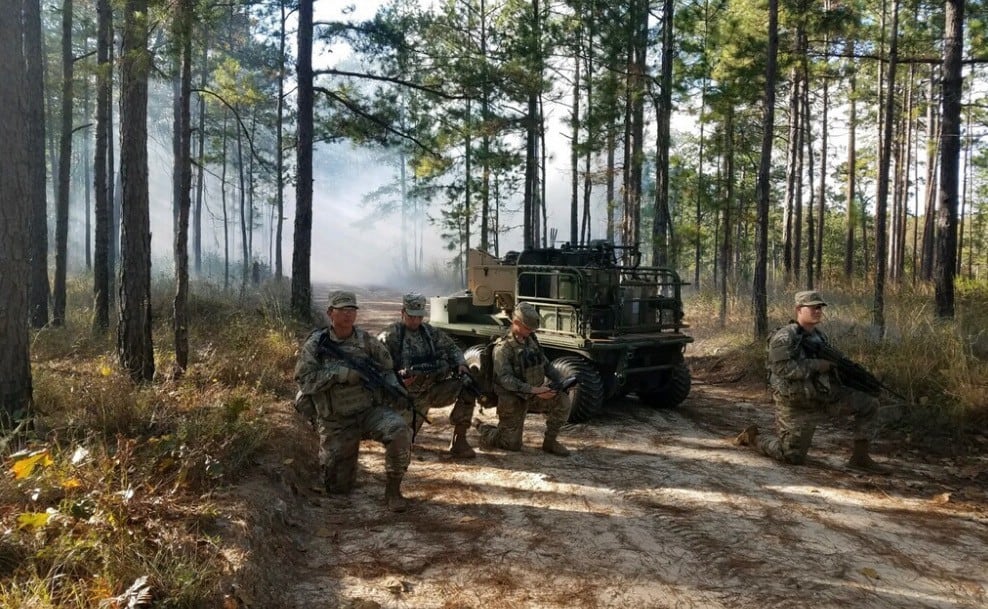While many of the Army’s vehicles are expected to be replaced in the near term, upgraded versions of the existing Stryker, an infantry carrier vehicle, are expected to keep the armored eight-wheelers as the central infantry carriers until 2040 or beyond.
To keep the centerpiece of mounted infantry in the fight, Col. Damien Mason, director of the Army Capability Manager Stryker Brigade Combat Team, has a running list of new technologies to insert into the platform.
Some of those have been launched or are being installed, others need new solutions to fill a growing gap of capabilities as SBCTs prepare for a potential ground fight with peer competitors like China or Russia.
Speaking at the annual Maneuver Capabilities Development and Integration Directorate out of the Maneuver Center of Excellence at Fort Benning, Georgia, on April 7, Mason laid out both the changes to the formation and gear that SBCT soldiers will see in the near and long-term future.
RELATED

For soldiers, some of the bigger changes will come in the setup of the formation.
The Army plans to add an electronic warfare platoon, a cyberspace electromagnetic activities cell, drones, additive manufacturing and drone maintenance platoons, an additional platoon to each cavalry squadron, two more artillery guns per battery, a third engineer company, robotic combat vehicle operators and an attached Mobile Short-Range Air Defense from the division level.
Those are some of the organizational changes being pursued right now, Mason said, to address the SBCT limits, which include:
♦ Limited ability to conduct electronic warfare, electronic attack, EW support and EW protection as well as cyberspace electromagnetic activities.
♦ Insufficient direct fire capabilities against pacing threats such as armored forces.
♦ Limited personnel and tech to control airspace at the lowest echelon from threats such as small drones.
♦ Multiple maintenance and support limitations for running an SBCT in resource-intense large-scale combat operations.
♦ Inability to simultaneously engage with both indirect and aerial fire on a target or threat.
To meet the current and future needs, Mason’s team showed attendees efforts that include addressing tactical radio shortfalls for mission command, Stryker upgrades, force redesigns that will alter the makeup of the SBCT, testing of new weapons and improvements to existing weapons.
The SBCT of the near future will have soldiers working inside and outside of the vehicle using the Army’s Integrated Visual Augmentation System, or IVAS. The “mixed reality” goggle allows soldiers to use sensors and software for everything from navigation to targeting and share their view and data with anyone in the network.
That will mean Stryker crew members can see what the dismounted soldier sees as they leave the vehicle and enter the battle. The vision is expected to work both ways, synching up the crew with infantry soldiers to better coordinate attacks and responses to threats.
At the same time, developers want the Stryker crew to see other platforms as well, such as small aerial drones and unmanned ground vehicles equipped with sensors, cameras and weapons.
The primary goal of changing the formation is to give the existing number of vehicles and soldiers greater capabilities without having to add more people or manned vehicles to the mix, Mason said.
As far as weapons testing goes, the Army is working on an upgraded Anti-Tank Guided Missile. Last October Stryker soldiers with the 8th Squadron, 1st Cavalry Regiment, 2nd Infantry Division, tested the new missile with its Modified Improved Target Acquisition System, or MTAS, in field conditions against an opposing force at Yakima Training Center, Washington.
The upgrade will allow each Stryker in the formation to “act as a sensor by transmitting situational reports and images” to the platoon, company and brigade, according to an Army statement.
The MITAS also works with a laser range finder for better accuracy, an upgraded missile launcher and better view with image enhancement and a high-definition color camera.
In testing, soldiers were able to capture images of targets more than 9 kilometers away and signal crewmembers to the location of the target through the network.
Testing continues for the Medium Caliber Weapon System, MCWS, a 30mm cannon upgrade for the Stryker. As does Common Remotely Operated Weapon System–Javelin, or CROWS-J.
The formation may also add some additional punch if testing on the 155mm wheeled howitzer proves successful, Mason noted.
That is an effort to give SBCTs a mobile howitzer platform for artillery support in place of towed howitzer systems. A shoot-off of competing platforms was underway early this month at Yuma Proving Ground, Arizona.
Todd South has written about crime, courts, government and the military for multiple publications since 2004 and was named a 2014 Pulitzer finalist for a co-written project on witness intimidation. Todd is a Marine veteran of the Iraq War.





